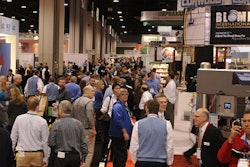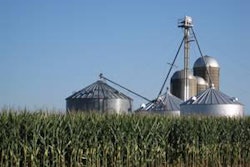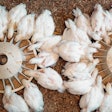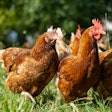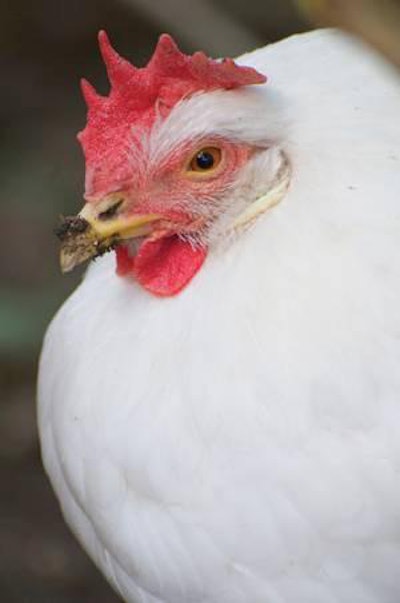
The 2013 International Poultry Scientific Forum in Atlanta provided a wealth of new information on several important poultry nutrition topics, including: value of low oil DDGS in poultry diets; use of high levels of DDGS in layer, broiler and turkey feeds; survey of mycotoxins in poultry ingredients and feeds; enzyme additions; and use of probiotics in poultry diets.
DDGS in poultry diets
There were at least eight presentations/posters presented on the use of DDGS in poultry diets. Most fortunately, two labs presented data estimating the metabolizable energy value of low oil DDGS in poultry. Dr. Nick Dale conducted true metabolizable energy tests on the same DDGS sample with varying levels of oil extraction and reported the results shown in Table 1. A strong (r =.98) regression equation was formulated (compared to Dale’s 2006 data) that showed a decrease of 38.6 kcal/lb for each one percent decrease in oil. He recommended an estimate of 2215-2240 kcal/kg for low oil DDGS when 5 percent of the fat remains and emphasized that the use of crude fat alone to make adjustments in energy value for DDGS may not be reliable for meat birds when material is being derived from a variety of sources.
Estimating apparent metabolizable energy
Dr. Michael Persia’s lab group at Iowa State University also conducted chick experiments to formulate a regression equation for estimating apparent metabolizable energy of DDGS samples based on oil content and estimated a 45.6 kcal reduction in apparent metabolizable energy per 1 percent decrease in DDGS oil content. Persias’ group worked with different DDGS samples, versus Dale’s group, which extracted more oil from the same DDGS sample. Nonetheless, work from both labs indicated a substantial loss in metabolizable energy from DDGS as oil is taken out, and estimated loss/percent of oil was very close (only 7 kcal difference).
Research conducted in broilers at Texas A&M AgriLife Research by Williams, et al., compared two different DDGS sources at three levels (5, 10 or 15 percent of diet) and reported a positive early body weight gain response (14d) in chicks fed DDGS–B sample compared to the control or DDGS–A sample groups. This positive response was negated by the end of the trial (40d).
There were no differences in feed conversion rate throughout the trial, leading the authors to conclude that broiler feeds may include DDGS up to 15 percent of the diet in least cost feed formulations.
Layer research
Layer research with DDGS was reported by researchers from Iowa State and the University of Kentucky. Iowa State researchers fed 15 or 30 percent DDGS in balanced rations to Hyline W36 hens from 30 to 46 weeks of age and concluded that level of DDGS in the ration did not significantly affect egg production parameters.
The University of Kentucky research fed very high levels of DDGS (25 or 35 percent) with a Programmed Nutrition premix (Alltech, Kentucky) formulated to provide equivalency of .10 percent AP and .1 percent calcium to the finished feed. During the 17-week lay period, diets formulated with lower AP and calcium with DDGS showed reduced eggshell strength and percent shell, which was fully alleviated by the premix addition at 25 percent DDGS inclusion rates and partially alleviated at 35 percent DDGS levels. Overall, the authors found no negative effects of up to 35 percent DDGS inclusion rates in laying hens diets (27 weeks of production) on hen day egg production or feed intake.
Use of microbials and enzymes
Researchers at North Carolina State University (Ferket and Grimes laboratory) reported on the use of direct fed microbials and enzymes (xylanase, amylase and protease) in turkey hen diets containing 6 or 18 percent DDGS. They reported that DDGS level did not affect body weight in the hens at 10 weeks of age, but the higher levels (18 percent) reduced 12 week hen weights but without affected feed conversion rate. Dietary supplementation of the enzyme blend and direct fed microbial may have improved early poult growth by a beneficial effect on mucosal development when dietary energy was reduced and high levels of DDGS were fed.
The final paper on DDGS presented that was of interest was by Dr. Srinivasan and coworkers from the Department of Agricultural and Biological Engineering at Mississippi State University on the removal of fiber fractions from DDGS, corn or soybean meal using the Elusieve process (patented by University of Illinois). Dr. Shrinivasan described how the patented Elusieve process removes the fiber component of a feed ingredient by both blowing air (elutriation) and sieving. This process increased protein content of DDGS by 2.3 percent and decreased the fiber component significantly.
Feeding diets formulated with corn, DDGS and soybean meal that had undergone the Elusieve process to broiler chicks resulted in greater body weight gain, increased breast yield and significant improvements in feed conversion rate. Some economic calculations were also presented indicating an estimated payback period of one to five years for investment in equipment to conduct the Elusieve process in a commercial feed mill. The fiber by-product of this process could be a good source of neutral detergent fiber in ruminant feeds.
Mycotoxins
Several papers presented results of world-wide mycotoxin surveys of poultry feed ingredients. Swamy et al., with Alltech, India, reported results of an analysis of 38 mycotoxins in 168 North American and European ingredient samples and found that only 10 of the samples were clear of all mycotoxins tested. Deoxynivalenol group mycotoxins were present in 75 percent of the samples, followed by fumonisins (59 percent), zearalenone (38 percent) and T02 group mycotoxin (31 percent). Fumonisins were present at the highest levels.
Naehrer, with Biomin, Singapore, reported results from their three-year survey of over 7,000 samples taken world-wide that 19 percent of the samples tested were negative for the five major mycotoxins tested (aflatoxin, zearalenone, deoxynivalenol, fumonisins and ochratoxin). The most abundant toxins found in their study were fumonisin (64 percent), followed by deoxynivalenol (59 percent), zearalenone (45 percent) and aflatoxin (33 percent). Bottom line: few poultry feed ingredients are totally clear of mycotoxins, thereby creating challenge to the immune system and health of poultry flocks worldwide.
Researchers at Texas A&M reported a 10-week feeding trial of laying hen diets naturally contaminated with deoxynivalenol, aflatoxin and fumonisin with a deactivating compound test product. They did not find a significant interaction between the deactivating compound and mycotoxin levels. Several organ weights were affected by mycotoxin contamination. Unfortunately, mycotoxins are a reality in poultry feeds and research needs to continue to be conducted to minimize their negative effects.
Pellet quality
As feed costs keep increasing, technologies to improve feed efficiency become more cost effective. Pellet quality of poultry feeds has been known to affect feed conversion rate of growing birds for awhile. Research reported from West Virginia State University re-confirmed the concept in turkey toms. Toms were fed 78.6 percent intact pellets compared to pelleted feed ground to a 1,108 micron particle size. Feeding the high quality pellets resulted in toms that were 0.29 kg heavier at day 118 with an improved feed conversion rate of nine points.
Regression analysis predicted that if the toms fed pelleted feed ground were finished to the same weight as the toms on the good pelleted feed weights at 188 days, the feed conversion rate advantages of good pellets would have been 12 points. This results in significant feed savings. A review of pellet quality at feed mills producing pellets for broilers and turkeys is warranted in today’s high cost feed environment.
Numerous papers were presented to report the efficacy of a number of feed additives ranging from new enzymes (proteases, carbohydrases, phytases); manno-oligosaccaride products; probiotics; prebiotics, etc., that can potentially improve the nutritive value of poultry feeds. I encourage readers to look at the abstracts of the International Poultry Scientific Forum for further information on these topics at: www.ipe13.org/ipsf/index.cfm


